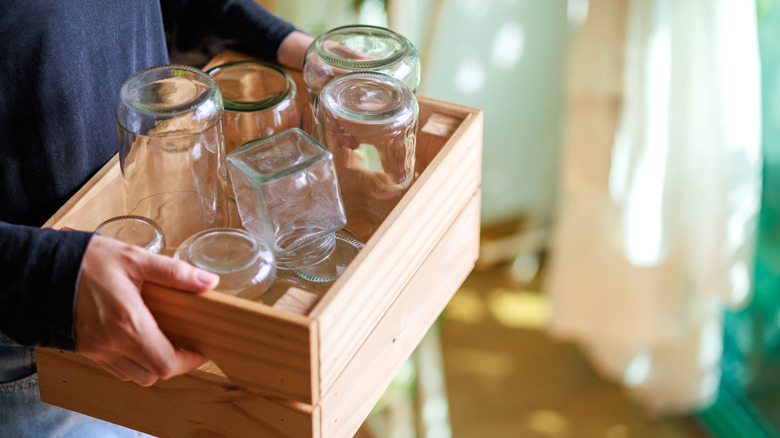How To Use Aluminum Foil To Make A Candle In A Pinch
The coldest days of the year are just around the corner, and in many parts of the U.S., that means power outages. Bad weather — think heavy snowfall and nasty winter storms — can knock out power infrastructure, and electrical systems get overloaded trying to meet community heating needs. Knowing how to whip up a source of light is guaranteed to come in handy. All you have to do is pour a neutral oil into a small-ish fireproof container, cover it with a folded piece of aluminum foil with a hole in it, and thread through a piece of string — now you can light your brand new oil candle to banish the darkness!
Sourcing an appropriate oil reservoir is the first step in making this emergency lamp. The vessel could be as small as a nail polish bottle or as large as a canning or Mason jar. If you want to use a glass jar or bottle, look for tempered or heat-resistant glass that's on the thicker side. Tin cans — empty of the food, of course — are another good option, whether it's a 4-ounce can of fish or a 15-ounce can of beans or vegetables. An old ceramic mug with a handle lets you carry your makeshift oil lamp through the house as you move from room to room. Whatever you decide to use, collect extra of these essential items for your home safety kit in case of a power outage in the future.
Gather everything
Other lamp body options include metal, ceramic, or glass trinket boxes, mini metal baking tins, or jars and tins made specifically for candle making. We like this 12-pack of pretty amber glass jars for $29.40 from Jar Store. If you're using an upcycled container, thoroughly wash and dry it before using it for this project — especially if it once contained a flammable substance. Next, gather the other household supplies you need to assemble the candle: a roll of standard aluminum foil, some string (cotton or wool yarn, twine made of natural fibers, lantern or candle wicks, or even a thin piece of old cloth — so long as it's not synthetic, it's appropriate), and some oil.
You can pretty much use whatever cooking oil you have on hand. For example, this is one of the many surprising uses for olive oil in your home (the use of olive oil in lamps predates Ancient Rome). Other options include vegetable, canola, sunflower, soybean, and even coconut oil, though note that coconut oil hardens at temperatures below 78 degrees Fahrenheit. The only tools you'll need are a pair of scissors or knife, and maybe a roll of paper towels to soak up any oil spills. Before assembling your candle, consider whether you want to personalize it. If you're truly in an emergency, this won't be necessary, but if you're making these candles for fun or festivities, decorating them is a great addition.
Make your candle
First, if you're making this candle for fun and your container is clear, you can add colorful glass beads, aquarium pebbles, or flowers and foliage. You can also use fresh or dried herbs or citrus fruit to scent the candle. Once your vessel looks pretty (if you choose to do these steps), it's time to construct the candle itself. From the roll of aluminum foil, tear a piece more than double the diameter of your container. Don't use a lot of aluminum foil or it will heat up and may become a fire hazard. Fold the piece in half. Next, grab your scissors and cut a length of string around half an inch longer than the height of your container. This is your wick. If you have time, you can fill a small bowl with the oil and leave the wick to soak.
Make a small hole that the string can fit through in the folded piece of foil. Thread your soaked wick through the hole, leaving about half an inch of string poking out on top. Fill your container with oil, leaving a gap at the top. Press the foil firmly to the sides of your container so there are no gaps. You don't want hot oil spilling onto your tabletop or, worse, your fingers as you carry the candle. If you didn't let the wick soak beforehand, give it a few minutes to soak in the container, then light it on up!

